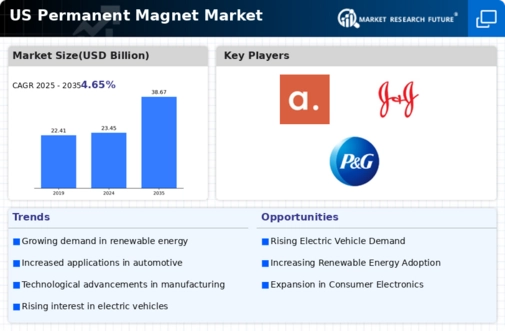Growing Renewable Energy Sector
The expansion of the renewable energy sector in the US is a pivotal driver for the permanent magnet market. As the country increasingly invests in wind and solar energy, the demand for efficient energy conversion technologies rises. Permanent magnets are integral to the operation of wind turbines and solar inverters, enhancing their efficiency and performance. In 2025, the renewable energy sector is projected to account for approximately 30% of the total energy generation in the US, which could lead to a substantial increase in the demand for permanent magnets. This trend suggests that manufacturers in the permanent magnet market must adapt to the evolving needs of the renewable energy industry to capitalize on growth opportunities.
Focus on Energy Efficiency Regulations
The heightened focus on energy efficiency regulations in the US is driving growth in the permanent magnet market. Government initiatives aimed at reducing energy consumption and promoting sustainable practices are leading to increased adoption of energy-efficient technologies. Permanent magnets are known for their ability to enhance the efficiency of electric motors and generators, making them a preferred choice in various applications. As regulations become more stringent, industries are likely to seek solutions that comply with these standards, thereby boosting the demand for permanent magnets. This trend suggests that the permanent magnet market will continue to grow as companies strive to meet energy efficiency goals.
Rising Demand for Consumer Electronics
The increasing demand for consumer electronics is another significant driver impacting the permanent magnet market. With the proliferation of smart devices, such as smartphones, tablets, and wearable technology, the need for compact and efficient components has surged. Permanent magnets are essential in various electronic applications, including speakers, microphones, and hard drives. The US consumer electronics market is anticipated to reach $400 billion by 2026, with a substantial portion of this growth attributed to advancements in technology and consumer preferences. This trend indicates that the permanent magnet market must adapt to the evolving landscape of consumer electronics to capture emerging opportunities.
Advancements in Electric Motor Technologies
The ongoing advancements in electric motor technologies are significantly influencing the permanent magnet market. Electric motors, which utilize permanent magnets for improved efficiency and performance, are increasingly being adopted across various industries, including automotive, aerospace, and industrial applications. The US electric motor market is expected to reach $25 billion by 2026, with a notable portion attributed to the use of permanent magnets. This growth is driven by the need for energy-efficient solutions and the push for electrification in transportation. As electric motors become more prevalent, the demand for high-performance permanent magnets is likely to increase, thereby propelling the market forward.
Increased Investment in Electric Vehicle Infrastructure
The surge in investment in electric vehicle (EV) infrastructure is a crucial driver for the permanent magnet market. As the US government and private sector stakeholders commit to expanding EV charging networks, the demand for electric vehicles is expected to rise. Permanent magnets play a vital role in the electric motors of these vehicles, enhancing their efficiency and performance. By 2025, the US is projected to have over 1 million public charging stations, which could lead to a significant increase in the production and sales of electric vehicles. Consequently, this trend is likely to stimulate the permanent magnet market, as manufacturers seek to meet the growing demand for high-quality magnets in the automotive sector.














Leave a Comment